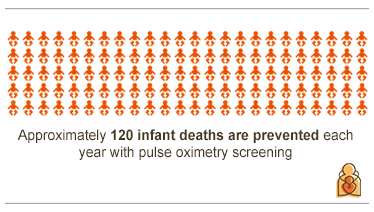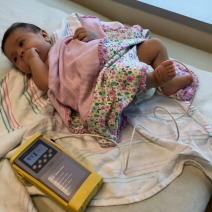How to Continuously Monitor O2 and Co2 of a Newborn
Most babies are born with healthy hearts and have enough oxygen in their blood. However, about 1 baby in every 100 is born with a congenital heart defect (CHD) and 25% of those babies with CHD will have a critical congenital heart defect (CCHD).
Babies with critical CHDs have low oxygen levels and usually require surgery or other procedures in the first year of life. Sometimes intervention must be done urgently, within the first days or weeks of a baby's life. Some examples of critical CHDs include coarctation of the aorta, transposition of the great arteries, hypoplastic left heart syndrome, and tetralogy of Fallot.
What is pulse oximetry?
Pulse oximetry (also called pulse ox) is a simple and painless test that measures the level oxygen is in the blood.
There are types of CCHD that cause lower than usual blood oxygen levels and those can be picked up by pulse oximetry―even before a baby becomes sick. Early detection and appropriate management can then be provided and may improve a baby's outcome.
The American Academy of Pediatrics (AAP) recommends pulse oximetry be performed at all newborn screenings to detect CCHD. As of 2018, policies for screening newborns have been implemented in all states in the U.S.
Fetal ultrasounds of the heart do not detect all types of heart defects.
While many problems in the fetal heart are now found early by fetal ultrasounds―and families are getting referred earlier to pediatric cardiologists for further care, there are still cases of CHD that can be missed.
Many newborns develop signs and symptoms of CCHD such as turning very blue or breathing fast right after birth. Those babies are diagnosed and treated before being discharged from the hospital. However, there are babies with certain types of CCHD who may look and act healthy for several days before becoming suddenly seriously ill at home.
How is this screening is done? |
|---|
What happens a baby fails the pulse oximetry screening?
If the screening test suggests a problem, additional testing to evaluate for CHD or for other potential causes of low oxygen will be necessary before the baby will be discharged from the hospital.
Testing may include a chest radiography and bloodwork. A thorough ultrasound of the baby's heart called an echocardiogram will be performed and read by a pediatric cardiologist. The echo will evaluate all the structures and function of the baby's heart in detail. If the baby's echo shows any problems, the baby's medical team will discuss next steps with the parents in detail. See Common Types of Cardiac Testing for more information.
Note: As with any screening test, sometimes there can be times when the pulse oximetry screening test is not correct. Sometimes there can be false positives, meaning that while the pulse ox screen suggests a problem, the echo will be reassuring that the heart is normal. Just because a baby fails the pulse oximetry screening test does not mean that the baby has a heart defect. There are other reasons that a baby may have lower oxygen levels, such as infection or lung problems. These are also very helpful to be picked up early. As well, some healthy babies can have a low pulse oximetry reading while their heart and lungs are adjusting after birth.
If a baby passes the pulse oximetry screening, does it mean he or she has no heart defects?
Unfortunately, no. Pulse oximetry testing picks up only some types of CHD. Heart defects which are not causing a low blood oxygen level at the time of the screen are not picked up by the test.
Even if a baby passes the pulse oximetry screening, parents should watch:
-
How well their baby is feeding
-
Any difficulty in breathing
-
Increased irritability
-
Excessive sleepiness
-
Bluish color to the lips or skin
-
Grunting
-
Fast breathing
-
Poor weight gain
Parents are advised to contact their baby's doctor right away if they notice any of these signs.
Additional Information & Resources:
-
Newborn Screening Tests
-
Tests & Screenings During Pregnancy
-
Challenges Faced by Parents of Children with Congenital Heart Disease
-
Genetics and Congenital Heart Defects
-
Endorsement of Health and Human Services Recommendation for Pulse Oximetry Screening for Critical Congenital Heart Disease (AAP Policy Statement)
-
Association of U.S. State Implementation of Newborn Screening Policies for Critical Congenital Heart Disease with Early Infant Cardiac Deaths (JAMA, 2017)
The information contained on this Web site should not be used as a substitute for the medical care and advice of your pediatrician. There may be variations in treatment that your pediatrician may recommend based on individual facts and circumstances.
jacksonmorelesucity.blogspot.com
Source: https://www.healthychildren.org/English/ages-stages/baby/Pages/Newborn-Pulse-Oximetry-Screening-to-Detect-Critical-Congenital-Heart-Disease.aspx

 A small soft sensor is wrapped around the baby's right hand and one foot. The sensor is hooked up to a monitor for about 5 minutes and measures the oxygen level in the blood and the heart rate. It is fast, easy, and does not hurt. Pulse oximetry screening is done after 24 hours after birth to allow the baby's heart and lungs to fully adjust to life outside his or her mother. After the screening is completed, the doctor or nurse will go over the reading with the baby's parents.
A small soft sensor is wrapped around the baby's right hand and one foot. The sensor is hooked up to a monitor for about 5 minutes and measures the oxygen level in the blood and the heart rate. It is fast, easy, and does not hurt. Pulse oximetry screening is done after 24 hours after birth to allow the baby's heart and lungs to fully adjust to life outside his or her mother. After the screening is completed, the doctor or nurse will go over the reading with the baby's parents.
0 Response to "How to Continuously Monitor O2 and Co2 of a Newborn"
Post a Comment